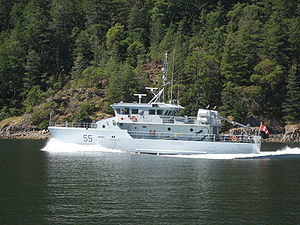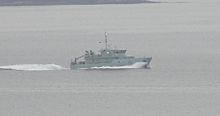- Orca class patrol vessel
-
Patrol Craft Training OrcaClass overview Name: Orca class Patrol Craft Training Builders: Victoria Shipyards, Esquimalt, BC Operators:  Royal Canadian Navy
Royal Canadian NavyPreceded by: YAG 300 Cost: C$90.7 million (entire project) Built: November 2004—October 2008 In service: 17 November 2006—Present Completed: 8 Active: 8 General characteristics Type: Training tender and patrol boat Displacement: 210 tons Length: 33 m (108 ft) Beam: 8.34 m (27.4 ft) Draught: 2.6 m (8.5 ft) Propulsion: 2 x Caterpillar 3516B diesel engines, 2,500 hp each at 1,600 rpm Speed: 20 knots (37 km/h; 23 mph) Range: 660 nmi (1,220 km; 760 mi) at 15 knots (28 km/h; 17 mph) Complement: 4 (minimum); 24 (maximum) Armament: None. Foredeck is strengthened to accept a 12.7 mm M2 machinegun. The Orca class is a ship class of eight steel-hulled Royal Canadian Navy training vessels. Based on the Australian-designed Pacific-class patrol boat, the Orca class was constructed by Victoria Shipyards between November 2004 and November 2008, at a total project cost of C$90.7 million. All are in service at CFB Esquimalt in British Columbia. They replaced the YAG 300 class and operate as training platforms and surveillance craft.
Contents
Design and construction
During the early 2000s, MARCOM began searching for a replacement for the 1950s-era wooden-hulled YAG 300 class used to train personnel.[1] Training aboard these outdated vessels while useful became less relevant as MARCOM moved to initial training aboard modern land-based simulators for training officers which more accurately replicated the conditions aboard the Kingston class patrol boats and Halifax class frigate. On 8 November 2004, the Department of National Defence announced a C$69.7 million contract for six new ships, with an option for two more,[1] for a total budget of C$90.7 million.[citation needed]
The Orca class ships are based on the Australian training vessel Seahorse Mercator, itself a derivative of the Australian-designed Pacific class patrol boat.[2] Each ship has a displacement of 210 tonnes, is 33 metres (108 ft) long,[1] has a beam of 8.34 metres (27.4 ft), and a draught of 2.6 metres (8.5 ft).[citation needed] To meet the training requirement, the Orcas are fitted with a larger-than-normal bridge and carry warship-grade navigational equipment.[2]
The Orcas are capable of 20 knots (37 km/h; 23 mph), and have an endurance of 660 nautical miles (1,220 km; 760 mi) at 15 knots (28 km/h; 17 mph).[1][2] Propulsion is provided by two Caterpillar 3516B marine diesel engines, each rated for 2,500 horsepower at 1,600 revolutions per minute.[2]
Each ship can be operated by a crew of four.[citation needed] Accommodation consists of two two-bunk cabins for the crew (Captain, Executive Officer, Bos'n, Engineer) and four or six-bunk cabins for 20 instructors and trainees[1] for a total of 24 bunks.
The eight vessels were constructed by Victoria Shipyards at Victoria, British Columbia.[2] The first ship in the class, Orca, was laid down in September 2005, launched in August 2006, and delivered to MARCOM in November 2006.[2] Delivery of subsequent vessels was set to occur every three months.[2] The project was completed when the eighth vessel, Moose, was delivered on 27 November 2008.[citation needed] The Orcas are not commissioned into service, so do not carry the HMCS ship prefix; instead, the prefix PCT (Patrol Craft Training) is carried.[citation needed]
Employment
The Orca class vessels are designated as "Patrol Craft Training".[2] The craft are primarily used to facilitate the two-to-six-week long 'at sea' component of naval officer training.[2] Their training capability is also extended to other naval personnel, and the Royal Canadian Sea Cadets.[2] Orcas are vessels of opportunity for surveillance and search and rescue.[2] They are all located at CFB Esquimalt.[citation needed]
Two vessels were temporarily fitted with .50-cal machine guns for port security during Op PODIUM. Op PODIUM was the Canadian Forces' support of the 2010 Vancouver Winter Olympics.[citation needed]
Ships in class
Name Launch date[citation needed] Delivery date[citation needed] Status edit] References - ^ a b c d e "New Training Vessels for the Navy: The ORCA Class". CDNMilitary.ca. January 2007 (updated). http://www.cdnmilitary.ca/index.php?p=25. Retrieved 23 March 2011.
- ^ a b c d e f g h i j k "Fast tests keep new Canadian navy training ships on schedule". Diesel Progress North American Edition (April 2007). http://findarticles.com/p/articles/mi_m0FZX/is_4_73/ai_n19041514/.
External links
- DND/CF page on the Orca class vessels.
- DND/CF Backgrounder BG-04.038 detailing the purchase process behind the Orca class.
- Canadian American Strategic Review.[dead link]
- CASR: Background — the Origins of the Orca Class Patrol Craft, Training.[dead link]
Categories:- Canadian Forces training ships
- Ships built in British Columbia
Wikimedia Foundation. 2010.
Look at other dictionaries:
Orca (disambiguation) — An orca or killer whale is a large marine mammal. Orca may also refer to: ORCA (animal welfare organisation) Orca (assistive technology), open source, assistive technology of the GNOME desktop environment Orca (dog), a golden retriever and winner … Wikipedia
Patrol boat — This article is about the naval vessel. For the Australian TV series, see Patrol Boat (TV series). Canadian Forces Kingston class Patrol boat … Wikipedia
Classe Orca — NCSM Orca en patrouille Autres noms PCT 55 Histoire A servi dans … Wikipédia en Français
Halifax class frigate — HMCS Regina (FFH 334) Class overview Name: Halifax class frigate Builders … Wikipedia
Fleet of the Royal Canadian Navy — The fleet of the Royal Canadian Navy consists of the surface warships, submarines and auxiliary vessels operated by the Royal Canadian Navy, the maritime component of the Canadian Forces. The current fleet consists of sixty six vessels, including … Wikipedia
Royal Canadian Navy — Logo of the Royal Canadian Navy … Wikipedia
Navy — Naval and Naval Force redirect here. For other uses of Naval , see Naval (disambiguation). For other uses of Navy , see Navy (disambiguation). The Spanish Armada fighting the English navy at the Battle of Gravelines in 1588 A navy (sometimes… … Wikipedia
Officer in charge (police) — The officer in charge (OIC) is the gazetted officer in command of a police station in Sri Lanka. He/she is in charge of most of the investigations of the station and for maintenance of law and order within that police area. Officer in charge can… … Wikipedia
List of Canadian Navy ships — This is a list of Royal Canadian Navy (RCN) ships that have served past and present, from 1911 ndash;1968 and Maritime Command (MARCOM) of the Canadian Forces from 1968 ndash;present. HMCS is the abbreviation for Her Majesty s Canadian Ship or… … Wikipedia
CFB Esquimalt — Infobox Military Structure name= CFB Esquimalt former Esquimalt Royal Navy Dockyard location= Esquimalt, British Columbia, Canada caption= type= Naval base built=1905 materials= used= 1842 present controlledby= Canadian Forces garrison=… … Wikipedia


